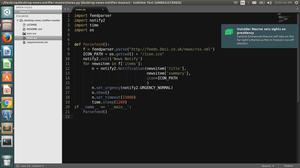021.Python的内置函数

内置函数
1 abs 绝对值函数
res = abs(-9.9867)print(res)
执行
[root@node10 python]# python3 test.py9.9867
2 round 四舍六入五凑偶
- n.5 n为偶数则舍去 n.5 n为奇数,则进一
- 奇进偶不进
res = round(3.5)print(res)
res = round(12.5)
print(res)
执行
[root@node10 python]# python3 test.py4
12
3 sum 计算一个序列得和
listvar = [1,2,34,34,43,32,5]total = 0
for i in listvar:
total += i
print(total)
res = sum(listvar)
print(res)
执行
[root@node10 python]# python3 test.py151
151
4 max获取一个序列里边的最大值
listvar = [1,2,34,34,43,32,5]res = max(listvar)
print(res)
执行
[root@node10 python]# python3 test.py43
5min获取一个序列里边的最小值
listvar = [1,2,34,34,43,32,5]res = min(listvar)
print(res)
执行
[root@node10 python]# python3 test.py1
6 sort找出最大值和最小值
listvar = [1,2,34,34,43,32,5]listvar.sort()
print(listvar)
res_min = listvar[0]
res_max = listvar[-1]
print(res_min)
print(res_max)
执行
[root@node10 python]# python3 test.py[1, 2, 5, 32, 34, 34, 43]
1
43
找出岁数最小的元组
listvar = [("张三",45),("李四",38),("王五",18),("田七",120)]def func(n):
#("张三",45)
return n[-1]
res = min(listvar,key=func)
print(res)
执行
[root@node10 python]# python3 test.py('王五', 18)
执行过程
("王五",18 扔到func当中 return 18首先把("张三",45) 扔到func当中 return 45
("李四",38) 扔到func当中 return 38
("田七",120) 扔到func当中 return 120
按照右侧实际年龄进行排序,找出最小的那个数,直接把元组返回.
7 pow 计算某个数值的x次方
res = pow(2,3)
print (res)res = pow(4,20)
print(res)'''pow(可以接受第三个可选参数 , 第三个参数是用来取余的)'''
res= pow(2,3,3)
print(res)
执行
[root@node10 python]# python3 test.py8
1099511627776
2
8 range产生指定范围数据的可迭代对象
res = range(10)print(res)
for i in range(10):
print(i)
for i in range(1,8):
print(i)
for i in range(1,16,3):
print(i)
for i in range(10,0,-1):
print(i)
执行
[root@node10 python]# python3 test.pyrange(0, 10)
0
1
2
3
4
5
6
7
8
9
1
2
3
4
5
6
7
1
4
7
10
13
10
9
8
7
6
5
4
3
2
1
9 bin将10进制数据转化为二进制
res = bin(15)print(res)
执行
[root@node10 python]# python3 test.py0b1111
10 oct将10进制数据转化为八进制
res = oct(8)print(res)
执行
[root@node10 python]# python3 test.py0o10
11 hex将10进制数据转化为16进制
res = hex(16)print(res)
执行
[root@node10 python]# python3 test.py0x10
12 chr将ASCII编码转换为字符
res = chr(97)print(res)
执行
[root@node10 python]# python3 test.pya
13 ord将字符转换为ASCII编码
res = ord("A")print(res)
执行
[root@node10 python]# python3 test.py65
14 eval 将字符串当作python代码执行
res = "print(123)"print(res)
eval(res)
res = "print('sdfsdf')"
print(res)
eval(res)
res = "print(\"sdfsdf\")"
print(res)
eval(res)
执行
[root@node10 python]# python3 test.pyprint(123)
123
print('sdfsdf')
sdfsdf
print("sdfsdf")
sdfsdf
15 exec将字符串当作python代码执行(功能更强大)
res = """for i in range(10):
print(i)
"""
# 要注意小心sql注入 delete from 数据 where id = 1 exec或者eval两个函数慎用
exec(res)
执行
[root@node10 python]# python3 test.py0
1
2
3
4
5
6
7
8
9
16 epr 不转义字符输出字符串
listvar = [1,2,3]res = repr(listvar)
print(res,type(res))
strvar = "123"
print(repr(strvar))
strvar = "111\n\t\r"
print(repr(strvar))
执行
[root@node10 python]# python3 test.py[1, 2, 3] <class 'str'>
'123'
'111\n\t\r'
17 hash生成哈希值
字典的键 和 集合当中的值 需要使用哈希算法哈希算法在存储上是无序的散列,经过计算之后会产生具有固定长度的唯一值
通过字符串和内存地址加在一起计算出来的 通过hash计算出来
res1 = "今天天气好"res2 = "今天天气好"
res3 = "132"
print(hash(res1))
print(hash(res2))
print(hash(res3))
执行
[root@node10 python]# python3 test.py-8085451974024421996
-8085451974024421996
-5108487044744349521
可哈希数据:Number(int bool complex float) str () [不可变数据]
不可哈希数据:dict list set [可变数据]
以上是 021.Python的内置函数 的全部内容, 来源链接: utcz.com/z/388513.html



